Recent Posts
RAIN, RAIN, RAIN
7/5/2024 (Permalink)
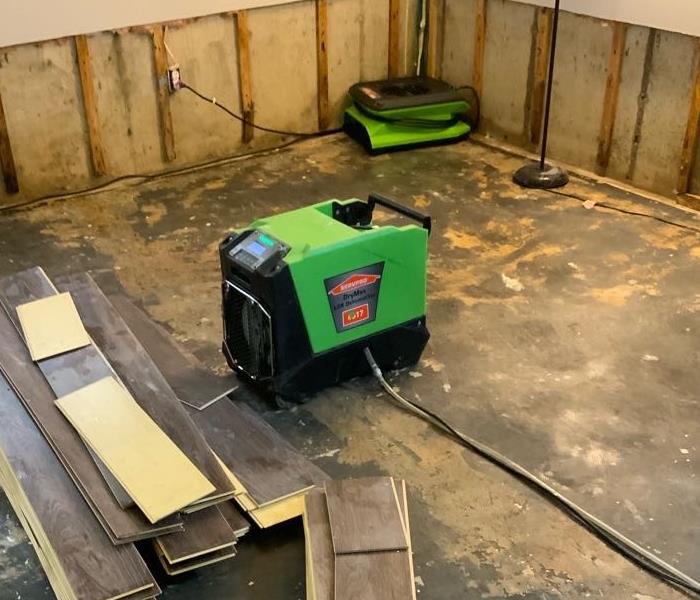 SERVPRO Specialty Equipment
SERVPRO Specialty Equipment
Heavy rain have inundated our area for the past several days. Anyone living in Hamilton or Oxford know exactly what I am referring to. The Hamilton SERVPRO team not only cleans up after water damages we have the equipment knowledge and training to get your home disinfected and dry. Next you will be ready for our highly trained reconstruction crew to get you back living the life you are accustomed to. The photograph below is an example of the equipment one might see after removal of the non salvageable water damaged materials. These dehumidifiers and air movers are designed specifically to maximize evaporation process leaving the remaining materials dry. This Trenton home took about two weeks start to finish. When disaster strikes we strike back, 24/7 SERVPRO is always here to help. 513-737-8776
Got Mold? We Can Help | SERVPRO of West Hamilton/Oxford
2/21/2024 (Permalink)
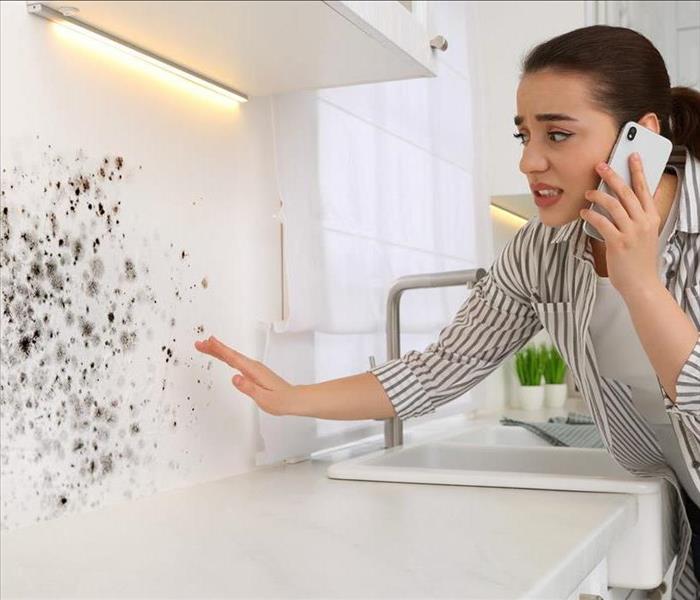 Has mold invaded your home? SERVPRO of West Hamilton/Oxford is here for the rescue. Call us today!
Has mold invaded your home? SERVPRO of West Hamilton/Oxford is here for the rescue. Call us today!
All homes are susceptible to mold growth, even if you think it will never happen to you. Mold is really persistent and can grow in many different areas as long as the conditions are right.
If you discover a mold infestation, you will probably react with disgust, and then not really know what to do after that. Even if you think you can clean it up by yourself, the mold could have spread under your floors or behind your walls and will continue to grow back until it is properly handled.
That’s where we come in! Our team will handle your mold situation with efficiency and confidence.
All About Mold
Mold spores are everywhere in our daily lives. They float through the air outdoors and they are even inside our homes. Open windows and doors can easily invite mold inside as well as through the vents in your HVAC system.
These spores are found everywhere, but they don’t grow everywhere. Mold needs to have a dark and damp environment to spread effectively, which means places like your attic, basement and crawl space are the most vulnerable.
Mold can be many different colors, ranging from black to bright green or even red. It can also have many different textures like slimy or chalky. However it looks and feels, it will probably have that familiar earthy or musty smell.
If your nose catches a whiff of this smell, it’s time to do some investigating. A single water leak or lingering moisture in your home is all it takes for mold to grow into a full colony just out of sight.
How to Reduce the Risk of Mold Infesting Your Home
Mold needs moisture, so the key to controlling potential mold infestations is to keep your home dry and to address leaks or moisture issues quickly. Keep your fans circulating and open windows in high-humidity areas like your bathrooms and kitchens from time to time.
Keeping your humidity levels on your thermostat between 30 and 50% is usually a good benchmark to keep moisture levels in check.
Addressing water issues quickly is another way to control your risk of a mold infestation. While a slow drip from a pipe or a leaky dishwasher may not seem like much, that’s all mold needs if the water gets under your floorboards or behind your walls. Stopping the flow of water and investigating mold growth can help you tackle these issues quickly.
Our Mold Remediation Process
If you do come upon a mold infestation somewhere in your home, leave it and call us right away. Some types of mold can be dangerous or even hazardous to breathe in, so let us handle it instead.
We will identify the type of mold and then contain the area so it can’t spread while we work. We will filter the air to remove the airborne spores while we work on cleaning and sanitizing the affected space.
If the mold has been growing for a while, a stubborn earthy odor may be left behind, so we will deploy our deodorizers to help remove the smell for good. We can also address any repairs if the mold degraded beams or ruined your walls. We will work hard to make sure your mold infestation becomes a distant memory!
Mold infestations should always be cleaned up by SERVPRO of West Hamilton/Oxford. Contact us right away.
Overcoming Biohazard Situations With Our Help | SERVPRO of West Hamilton/Oxford
11/21/2023 (Permalink)
 Biohazard situations can be extremely damaging and dangerous. Call SERVPRO of West Hamilton/Oxford today! We are Here to Help®.
Biohazard situations can be extremely damaging and dangerous. Call SERVPRO of West Hamilton/Oxford today! We are Here to Help®.
The only predictable thing about life is that it is unpredictable. Emergencies, accidents and the unexpected can take us by surprise at home and at work that can leave significant impacts on our day-to-day lives.
Sometimes those situations can even result in dangerous or hazardous messes to deal with. For example, sewage leaks can happen at a moment’s notice and leave you with a dangerous predicament.
Thankfully, our biohazard team is here to help when you need it. We are trained in the latest and safest restoration techniques that will help you recover safely and efficiently.
Why Professionals Should Address Biohazards
Minor accidents or a few drops of blood can usually be handled on your own or by your janitorial staff, but more serious situations should always be handled by trained professionals. That’s because some really dangerous substances can be lurking in things like sewage, blood or chemicals.
We are trained to handle every sort of situation, including chemical spills, sewage leaks, bloodborne pathogens, hoarding scenes, and animal waste or remains removal.
Did you know that even fresh water can become a biohazard if it is left on your floor for too long? Bacteria can start to grow and make you really sick if it isn’t properly handled. Our team has the proper PPE and training to handle these kinds of substances safely. We will contain the area, address the cleaning and sanitizing needs and handle repairs if the situation calls for it.
Crime Scene Residue Cleanup
Being the victim of a crime is one thing, but having that crime occur at your home or business is entirely another! In addition to the sheer emotional distress of the situation, your personal space is now open for all kinds of authorities and crime scene techs to take over.
Once everyone has gotten the evidence they need and have left, the reality of what just happened can set in and the feeling can be overwhelming.
Oftentimes, victims of a crime are left to deal with the cleanup and aftermath on their own. We are on a mission to help take the strain off of this process! Our crime scene cleanup crew can remove any signs of the crime scene processing like leftover fingerprint powder, pepper spray or tear gas residue, and the remnants of fire extinguisher chemicals. We can also safely clean up blood or other bodily fluids if the situation requires it.
Our biohazard crew is here for you through thick and thin. Call us the moment you discover a dangerous or mysterious substance at your home or on your property and we will get to work for you.
Let our biohazard team clean up your mess. Contact SERVPRO of West Hamilton/Oxford today.
The Speed of a House Fire | SERVPRO® of West Hamilton/Oxford
5/19/2023 (Permalink)
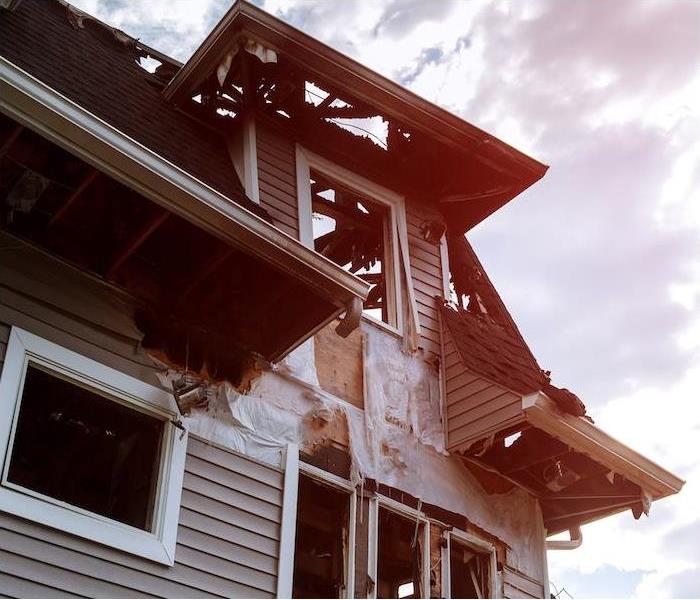 Fires spread fast. When disaster strikes, call SERVPRO of West Hamilton/Ohio to help so you can focus on what matters most.
Fires spread fast. When disaster strikes, call SERVPRO of West Hamilton/Ohio to help so you can focus on what matters most.
Experiencing a house fire is one of the more overwhelming and frankly terrifying things a homeowner can go through. Any time a fire breaks out in a place that it shouldn’t, it can spread quickly and cause widespread damage in a short amount of time. Some fires can’t even be contained, leading to a total loss of home or property.
If a fire starts in your home, getting out safely should always be your top priority. Understanding the progression of a house fire and how to get out quickly is crucial to ensure everyone in your family remains safe.
Fire Spreads Fast
All it takes is a single spark from an unattended candle or a kitchen towel too close to a stove burner for a fire to start. Once something flammable is ignited, it only takes about 30 seconds for the small flame to become a large fire.
From there, it is only a matter of minutes before that fire has created enough black smoke to fill a room or the entire house.
Once that smoke is in the air, it can become virtually impossible to see. That black smoke is thick and can throw an entire room into darkness. In under two minutes, the fire and smoke can become life-threatening and in under five minutes, your entire home could be engulfed in flames.
How You Should React
If a fire starts while you are home, your first priority should be to get out of the house as quickly as you can and call 911.
The fire will quickly start to produce black smoke, so stay low to the ground as you find your exit. The toxic smoke and gasses that fire produces can make you disoriented and drowsy, so crouch or crawl towards your exit if you have to.
Once you are outside, head to your pre-discussed meeting location and ensure that all of your family members have made it out safely. By this time, the fire department should be arriving soon and will take over to extinguish the flames and control the situation.
What to Do After
Standing in the aftermath of a house fire can be a really isolating and overwhelming experience. If the fire was widespread, you could be dealing with a full reconstruction as well as coming to terms with the loss of your possessions and keepsakes.
Our SERVPRO of West Hamilton/Oxford team understands the sensitive and stressful nature of experiencing a house fire, and we will help guide you through the restoration process one step at a time.
We will work together to create a restoration plan, and we will do our best to save as many of your possessions as possible. We are here 24/7 to respond to your call for fire damage restoration.
We can help you recover from any sort of fire disaster. Contact us at SERVPRO of West Hamilton/Oxford.
How Leaky Faucets and Mold Growth Go Hand-In-Hand
1/24/2023 (Permalink)
 A leaking faucet can be a small inconvenience or a big problem, depending on where the leak occurs.
A leaking faucet can be a small inconvenience or a big problem, depending on where the leak occurs.
If you have a leaking faucet, it is important to get it fixed as soon as possible. Fixing a leaking faucet could be a simple fix or could require extensive repairs. In this article, we will discuss tips and tricks for dealing with a leaky faucet.
Timing is Everything
A leaky faucet can be a small inconvenience or a big problem, depending on where the leak occurs. A slow drip from your bathroom sink may seem like no big deal, but if it's been going on for months and you haven't done anything about it, you could have an expensive problem on your hands.
When leaks are left alone for long periods of time, mold has been known to grow in the area around the source of the leak. The longer a leak goes unrepaired, the worse the mold buildup will become — and since mold tends to go undetected until its effects become visible (such as when it discolors walls or causes ceilings to cave in), its presence can lead to further damage throughout your home.
If you find yourself with a leaky faucet, it's important to clean up the water within 24-48 hours of its onset. This is the ideal time frame for mold growth prevention. If you're not able to clean it up in this window, call a professional. The longer the water sits and drips, the more mold will grow in your home and on surfaces such as floors and walls.
Fixing the Problem
What should you do if your faucet starts leaking? First of all, turn off the water supply while working on fixing it so that there is no extra water coming out of it while working on it. If there's not enough space under your sink for you to work comfortably, then move things around so that there is more room for yourself underneath the sink.
Small Leak Can Cause Major Problems
While it's true that a small leak from a faucet can cause major problems if left unchecked for too long, it does not necessarily mean that you will develop mold in your home. Mold can grow anywhere there is a water source, but mold still needs time to grow.
Mold spores are microscopic and float throughout our environment. The spores need something damp to feed on in order to grow into colonies of mold. If this dampness is present in your home, then you may have an issue with mold development on your property.
A leaking faucet can be a small inconvenience or a big problem, depending on where the leak occurs. If you have a leaking faucet, it is important to get it fixed as soon as possible. When you have a leaky faucet that leads to a mold problem, SERVPRO of West Hamilton/Oxford is here to help you get your Oxford home back to normal as quickly as possible. Give us a call at the first sign of mold.
How To Clean Up Water Damage After a Water Leak
12/5/2022 (Permalink)
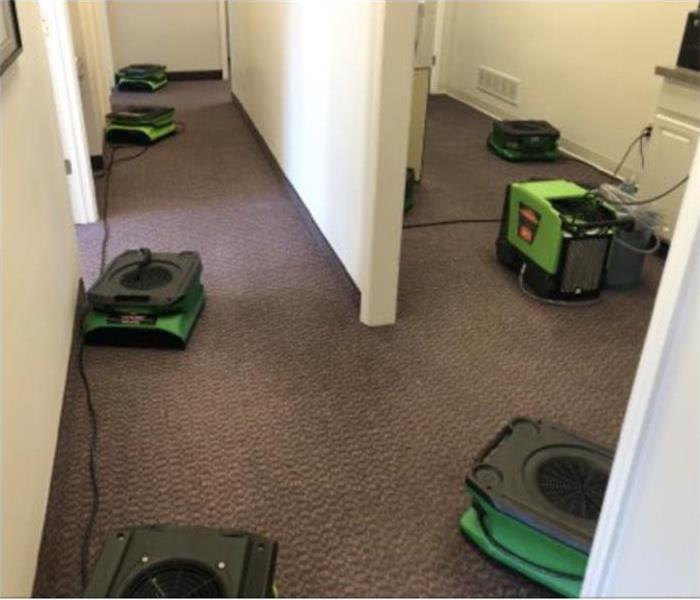 Water damage in Hamilton, OH.
Water damage in Hamilton, OH.
Tips for Cleaning Up a Water Leak
Water damage is one of the most common reasons for a home insurance claim, and it can happen in a variety of ways. You might experience a burst pipe, see signs of water damage after a storm, or even notice water seeping from your walls. Regardless of what caused the leak or how much water got into your home in Hamilton, OH, SERVPRO of West Hamilton/Oxford is here to help! We offer mold remediation services along with our water mitigation services so you can get back on your feet quickly.
Shut off the water
Shut off the main water valve. This is typically located in your basement or garage, and it will look like a big red knob on a pipe with a blue handle. If you don't know where this is, call a professional to help you turn the water off right away.
If that's not an option, call a professional anyway! You can wait until another day to find out where it is or how to turn it off—but by then there might already be damage done!
Contact your insurance company
If you have an insurance policy, you should contact your agent or company immediately to file a claim. The sooner you call them after a leak has occurred, the less time there will be for mold to grow.
Mold can easily spread throughout your home if left alone for even short periods of time—but it can also be removed with some effort and patience. To prevent mold from growing back in its place, it is important to have a trained restoration professional on-site as quickly as possible to take care of the mold remediation.
Make sure the area is safe.
Once you have the wet area secured, it's time to move on to the next step: making sure everything is safe. Make sure that all appliances and heating vents are turned off and do not turn them back on until they've been inspected by a professional who can be sure they are safe. Also check your electrical system for any signs of damage or fire hazards before touching anything else.
Call SERVPRO of West Hamilton/Oxford immediately
When you have water damage in your home or business, it's important to act fast and call SERVPRO of West Hamilton/Oxford immediately. We can help with everything from the initial response that prevents further damage to professional drying, cleaning and restoration services. The faster we get into the affected area, the better our chances are of saving your home and personal possessions from water damage.
The sooner we begin working on your project, the more likely it is that we'll be able to minimize structural issues as well as prevent mold growth. If you wait too long after a leak occurs before calling us for help, then we may not be able to perform services like removing drywall or carpeting because these materials would have already been damaged by mold growth. Call us first so that one of our trained technicians can start treating your property right away!
Water damage is something that no homeowner wants to deal with. And when it happens, it’s important to act quickly. If you do find yourself with water damage after a leak or flood in your home, contact SERVPRO of West Hamilton/Oxford immediately so we can help you get back on track as soon as possible.
Preventing Your Pipes From Freezing
11/21/2022 (Permalink)
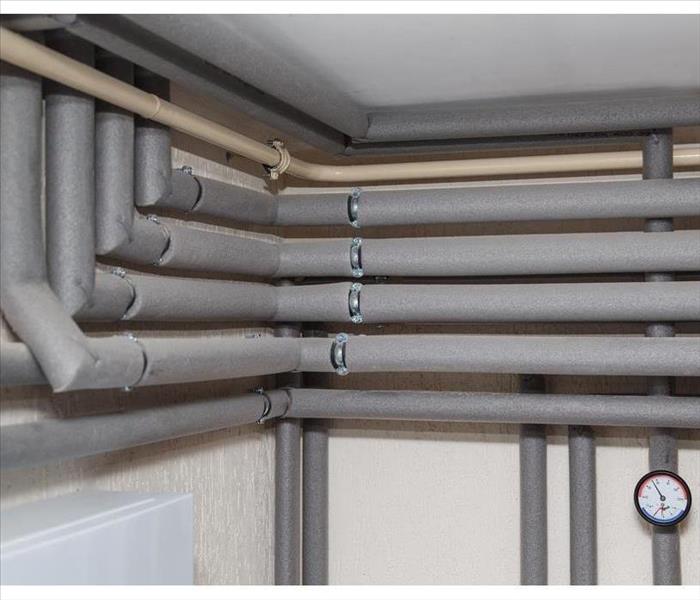 Insulate any exposed pipes that are vulnerable to freezing
Insulate any exposed pipes that are vulnerable to freezing
Keep Your Pipes From Freezing
If you live in a colder climate, the danger of frozen pipes is real. If your home's water supply freezes, it can cause serious damage to home appliances and fixtures. The good news is that there are steps you can take before and after the coldest days of winter strike to prevent frozen pipes from occurring in your home.
When Temperatures Drop Below Freezing, Beware of Freezing Pipes.
When temperatures drop below freezing, it is time to worry about water pipes in your home freezing. Frozen pipes can burst and cause flooding, they can cause damage to your Hamilton, OH home's foundation or structure, and they can also cause water to leak into your home. If the water is not contained within a frozen pipe, it will start seeping through cracks in the wall or flooring. This can lead to mold and mildew growth.
There are several ways that you can prevent freezing pipes:
- Insulate your water supply lines with foam insulation tape if possible
- If you cannot access these lines directly then use an insulation blanket around them instead
- Be sure any windows that do not have storm shutters on them are covered properly with clear plastic sheets so cold air does not enter through them
- Keep all vents closed off from areas that could be exposed due to drafts causing cold air currents
How to Avoid Pipe Freezing
Use heat tape. If you have an electric water heater, consider running a small space heater near it. You can also use heat tape to insulate valves and pipes in your basement or crawlspace, but keep in mind that it's a fire hazard if used improperly.
Use insulation. Insulate any exposed pipes that are vulnerable to freezing by wrapping them with foam or cloth pipe sleeves or other types of insulation. Before wrapping them up though make sure there are no leaks first!
Check for leaks and turn off the water supply when you leave your house, so you don't come back to frozen pipes.
How To Thaw Frozen Pipes
There are several ways to thaw frozen pipes. The best way to thaw them is by using hot water, but not just any old hot water -- you need to ensure that the temperature is high enough so that it will be able to melt the ice without damaging your pipes.
If you want to use hot water, here are some options:
Use a hair dryer set on "high" and directed at the pipe. This will take longer than other methods but won't damage your plumbing.
If there's an outlet nearby where you can plug in a space heater or blow dryer, turn those appliances on low and point them at the affected area for ten minutes or so until everything melts away. You can also try putting towels soaked in very hot water against frozen pipes; they'll help transfer heat into them faster than if they were left alone in the cold air around them!
Alternatives to Permanent Pipe Freezing Protection
While protecting your pipes from freezing is important, there are other options that can help you save money on heating costs.
Insulate the spaces around your pipes. If you have an attic or basement, it's a good idea to insulate any areas where cold air or water might be able to get inside and freeze the pipes. You can also insulate crawl spaces or basements if they're exposed to outside temperatures all year round. This will help keep the temperature inside these areas warmer than outside, preventing freezing in those places as well.
Replace outdoor faucets with frost-proof models or reroute pipe runs so that they don't run through unheated areas such as garages or porches during winter months of low humidity (this is what I did for my outdoor spigot).
Place space heaters near pipes that may be prone to freezing during cold weather periods when regular heating systems aren't working properly.
The best way to prevent pipe freezing is to keep your home warm by using space heaters or blankets. If you cannot afford these options, then you can use a blow dryer on low and place it near the pipe that has frozen. Another option would be to wrap the frozen pipe in towels soaked in hot water as soon as possible; this should thaw out any pipes that have been damaged due to cold temperatures outside your home.
Basic First Aid for Burns
10/10/2022 (Permalink)
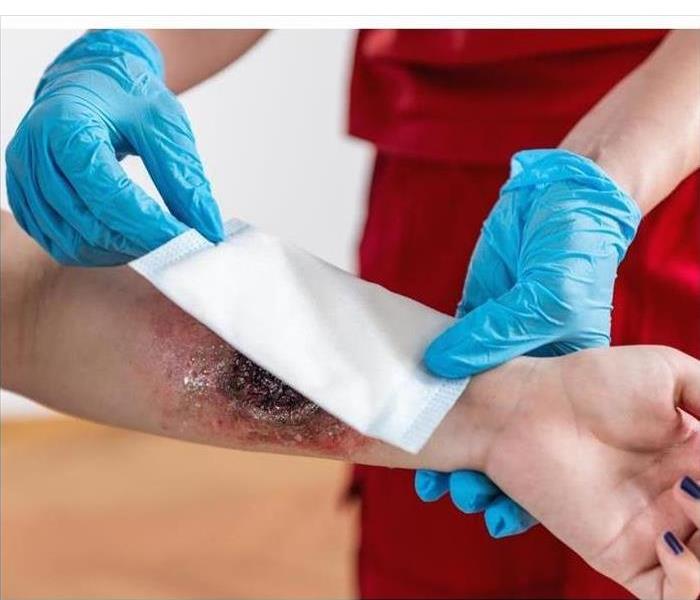 Burns can be painful and dangerous.
Burns can be painful and dangerous.
Steps to Minimize the Impact on Minor Burns
Burns are painful, but they can be prevented and treated if you know what to do. If you or a friend or family member has experienced a major burn, the first thing to do is to call 911. However, for more minor burns, there are a few easy steps to help minimize the impact of the burn.
Remove all jewelry and clothing from the burn area.
While it's important to keep the burn area clean, you should also remove all jewelry and clothing from it. This will allow for easier cleaning and evaluation of the area. If the burn is on your face, remove any glasses or contact lenses that might be affected by water. If you have an injury on your hands or feet, take off any rings or watches.
Flush the burned area under running water for at least 20 minutes.
The best way to clean a burn is to flush it with water. The water should be as hot as possible without causing further damage. Do not apply ice or cold water, as this will only worsen the injury by causing pain and swelling. If you can do so, run the tap at full force for 20 minutes or longer if necessary.
If the burn blisters, leave it alone.
One of the worst things you can do is pop a burn blister. The fluid inside the blister is filled with white blood cells and they help your skin heal faster. If you pop it, those white blood cells leak out, making your skin take longer to heal and making it more likely that scarring will occur.
If the burn area has blisters, don't rub them or apply any ointments or creams. This can increase swelling around the burns and make them more painful. You should also avoid using ice or cold water on burns because it could damage tissue underneath the burned area by chilling it too quickly (this will make healing take longer). Finally, if there are blisters present on your burn: don't try covering them with a bandage because this increases friction between the bandage and injured body parts.
If any signs of infection develop, seek medical attention immediately.
If any signs of infection develop, seek medical attention immediately. Signs of infection include redness, swelling, pain or tenderness at the burn site and pus-like drainage. Infection can lead to sepsis (blood poisoning) if left untreated and should be treated by a doctor as soon as possible.
Burns result in a lot of pain and can easily become worse, so it's important to know what to do in case of an accident.
Burns can be painful and dangerous, so it's important to know what to do in case of an accident.
A burn is caused by the contact with heat or fire and results in a lot of pain. It can also become worse over time because burns can easily become infected, lead to scarring, or cause shock.
Burns are one of the most common injuries, and they can be very serious if left untreated. If you ever have a burn, make sure to follow these guidelines to minimize the damage and improve your chances of full recovery.
5 Tips to Prevent Spring Flooding at Your Business
8/30/2022 (Permalink)
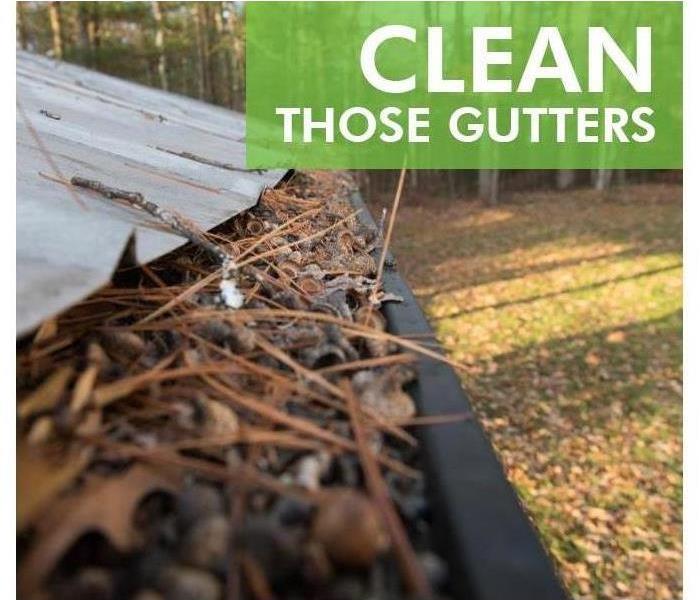 Gutters can collect a large amount of debris.
Gutters can collect a large amount of debris.
Prevent Spring Flooding at Your Business
After a long winter, it is finally time to start planning for the warmer months ahead. If you own a business in Ross, OH, spring can be a busy season for profits, but it also is a busy season for flooding. Fortunately, there are things you can do to prevent problems during the next thaw. Follow these steps to reduce the chances of needing to hire a water damage restoration professional once the weather warms up.
1. Relocate Snow
Never underestimate the water capacity in a pile of snow. For this reason, you will want to clear any away from the building's foundation. Ideally, snow should be at least three to five feet away, but the further away it is, the better.
2. Clean Out Gutters
After dealing with the snow, you will need to lookup. Over a long winter, gutters can collect a large amount of debris. Leaves, sticks, and dirt can lead to blockages which can force water to seep into the building.
3. Make Repairs
Next, look around the property. Few things lead to flooding like a frozen pipe. Check plumbing carefully. Seal leaks and insulate exposed pipes. While making repairs, do not forget the foundation. If you see cracks, do not ignore them.
4. Optimize Landscape Drainage
How does water drain around the building? If necessary, regrade the surrounding land to allow for better drainage. You may need to move plants and soil to do this, but it can be worth it.
5. Consider a Professional Inspection
If you are still feeling unsure about how your building will hold up to this spring's thaw, scheduling an expert inspection can give you a peace of mind. Sometimes, it is just better to know.
When the weather finally warms up, your business should experience spring profits, not a spring flood. By following these steps, you can reduce the chances of encountering common flooding problems.
How To Conduct an Emergency Drill in a Commercial Building
8/27/2022 (Permalink)
 People evacuating a building in Trenton, OH.
People evacuating a building in Trenton, OH.
Steps To Run a Drill
A fire drill does not only prepare you and your employees for potential blazes in your commercial property. It can also help everyone learn how to evacuate the premises during major storms that damage the building.
Drills alert you to potential issues so you can correct them before an actual emergency occurs. Ideally, you should hold storm drills for your Trenton, OH, building at least twice annually. Here are some tips for making the most out of these drills.
1. Make an Evacuation Plan
Before you hold your next drill, ensure everyone in the office knows and understands the evacuation strategy. Map routes to the nearest exits and highlights the locations of the alarms. You should also create a communication system that keeps each employee informed about the status of the storm.
2. Set Goals
Judge your fire drill based on how long it takes everyone to evacuate the building and shut down the equipment. Set a realistic time frame for the completion of the drill and try to meet or beat that goal.
3. Rehearse
Start by doing a walkthrough of the drill with members of the emergency response team. Then hold the drill with as many of your employees as possible.
Once everyone has mastered the basic evacuation strategy, try adding some obstacles such as broken elevators and blocked stairwells. To make the drill even more realistic, have a designated employee practice calling 911 and/or cleanup and restoration professionals.
4. Observe
Have a few members of your team observe the drill in its entirety. They should specifically look for behaviors or problems that could be dangerous during a real storm. These individuals can then hold a debriefing after the drill to discuss anything that went wrong.
The above steps should help you run an efficient and effective fire drill. This way, if a severe storm forces you and your employees to evacuate, everyone will understand what to do.




 24/7 Emergency Service
24/7 Emergency Service









